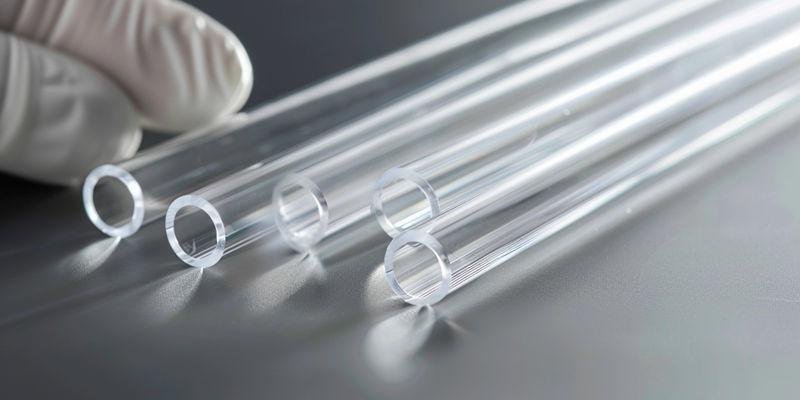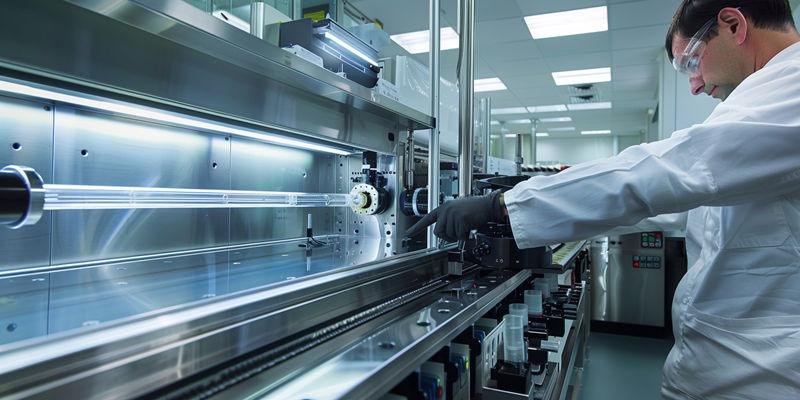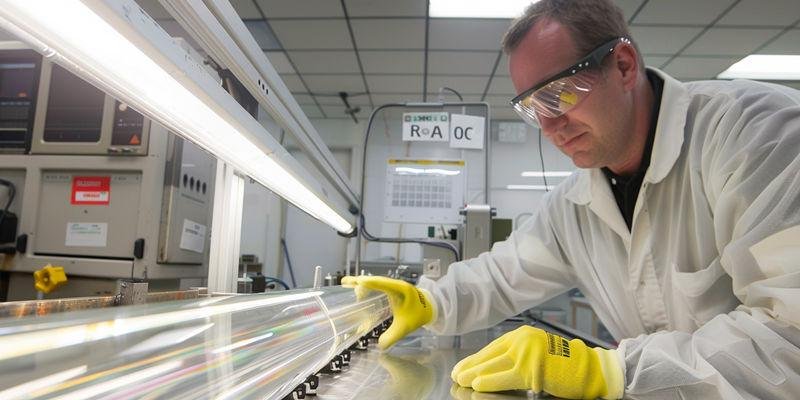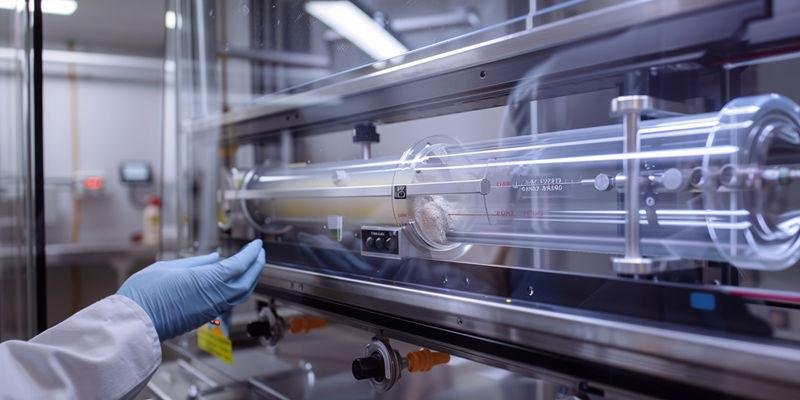
Quartz tube end finishes directly impact laboratory and industrial performance. Each finish type serves a unique function. Standard cut ends offer cost efficiency, fire-polished ends maximize vacuum sealing, ground flat ends provide precise alignment, optically polished ends deliver superior clarity, and custom geometries enhance mechanical or thermal properties. Engineers select the optimal finish by evaluating sealing, optical, mechanical, and thermal demands for each application.
Key Takeaways
Choose fire-polished ends for vacuum sealing. They create smooth surfaces that prevent leaks and ensure high purity.
Use optically polished ends for applications needing high clarity. These finishes support accurate measurements in optical systems.
Select precision ground ends for critical alignment. They maintain tight tolerances, ensuring reliable performance in optical instruments.
Standard cut ends are cost-effective for non-critical applications. They provide basic functionality without high expenses.
Consider custom geometries for specialized needs. Tailored finishes can enhance performance in unique laboratory and industrial setups.
What Are the Available End Finish Options for Quartz Tubes?

Quartz tube end finishes come in several types, each designed for specific laboratory and industrial needs. The main options include standard cut, fire-polished, ground flat, optically polished, and custom geometry ends. Understanding quartz tube specifications ensures optimal performance selection, whether the goal is sealing, alignment, clarity, or specialized function.
Standard Cut and Fire-Polished Ends for General Purpose Applications
Standard cut ends result from diamond sawing or scoring, producing a frosted surface with a roughness of 200-500Å RMS and dimensional tolerances of ±0.3-0.5mm. These ends work well in non-critical applications, such as open-ended furnace tubes or tubes that will undergo further machining. Fire-polished ends, created by briefly exposing the tube to a high-temperature flame, melt the surface to form a smooth, transparent finish. This process removes microcracks and strengthens the tube, making it suitable for vacuum sealing and visual inspection.
The fire-polished finish enhances strength by fusing the surface, which eliminates breaks in surface tension. This improvement supports leak-tight seals in vacuum systems, with helium leak rates below 1×10⁻⁹ mbar·L/s. However, the process can introduce minor geometric distortion, so users should consider the trade-off between strength and tight tolerances. Standard cut ends remain the most cost-effective choice for applications where end geometry is not critical.
Key summary points:
Standard cut: Cost-effective, rough finish, suitable for non-critical uses.
Fire-polished: Smooth, strong, ideal for vacuum sealing and clarity.
Trade-off: Fire-polished ends offer strength but may affect dimensional precision.
Precision Ground and Lapped Ends for Dimensional Accuracy Requirements
Precision ground ends use abrasive grinding to achieve flatness within 25-50μm and perpendicularity within 0.1-0.3°. This process removes 1-3mm of material, resulting in a frosted, translucent surface with 80-120Å RMS roughness. These ends are essential for applications that require precise tube-to-tube mating, such as optical assemblies or high-pressure sealed systems.
Dimensional accuracy ensures repeatable alignment and reliable sealing against O-rings or gaskets. Manufacturers use coordinate measuring machines to verify flatness and perpendicularity, ensuring that ground ends meet strict tolerances. This level of precision supports critical alignment in optical instrumentation and mechanical assemblies.
Cause | Effect |
|---|---|
Precision grinding | Achieves high flatness and perpendicularity |
Tight tolerances | Enables reliable alignment and sealing |
Frosted surface | Improves adhesive bonding and gasket grip |
Optically Polished and Custom Geometry Ends for Specialized Functions
Optically polished ends undergo multi-stage polishing to achieve less than 20Å RMS roughness and a scratch-dig rating of 20/10 or better. These finishes support high optical clarity and minimal wavefront error, making them ideal for spectroscopy, laser tubes, and optical windows. Custom geometry ends, such as flanged, beveled, or domed profiles, address unique mechanical or thermal requirements.
Specialized functions often require these advanced finishes. For example, customized cuvettes enable vertical flow in gravity-driven analyzers, serve as inline process monitoring windows, or allow dip-in sampling for rapid optical measurements. Custom geometries can also improve system performance, as seen when a German oven manufacturer reduced temperature variance and increased processing speed by using tailored tube ends.
Key summary points:
Optically polished: Delivers high clarity for optical and photonics applications.
Custom geometry: Solves unique mechanical or thermal challenges.
Specialized use: Supports advanced laboratory and industrial setups.
How Do Fire-Polished Ends Optimize Performance in Vacuum and Sealed Laboratory Systems?
Fire-polished ends play a critical role in laboratory and industrial systems that require vacuum integrity and chemical purity. These finishes create smooth, transparent surfaces that support leak-tight seals and prevent contamination. Engineers often choose fire-polished ends when system performance depends on both cleanliness and reliable sealing.
Vacuum Distillation and Rotary Evaporator Applications in Analytical Labs
Vacuum distillation and rotary evaporators rely on strong seals to maintain low pressures and prevent sample loss. Fire-polished ends provide a continuous, defect-free surface that eliminates microcracks, which can otherwise cause leaks or outgassing. This smooth finish also reduces the risk of damaging O-rings during assembly.
The optical clarity of fire-polished quartz supports visual monitoring of distillation processes. Sub-micron wall smoothness preserves beam coherence for optical sensors, while the pre-cleaned surface prevents contamination in sensitive experiments. Analytical labs benefit from the absence of detectable outgassing at 10⁻⁸ Torr, ensuring high purity in sealed systems.
Key advantages of fire-polished ends in analytical labs:
Leak-tight seals for vacuum integrity
Smooth surfaces that protect gaskets and O-rings
High optical clarity for process monitoring
Hermetically Sealed Discharge Lamp Manufacturing
Manufacturers of discharge lamps require hermetic seals to maintain gas purity and lamp longevity. Fire-polished ends deliver a continuous glass surface that supports reliable fusion sealing or adhesive bonding. This finish eliminates surface flaws that could act as leak paths under high voltage or thermal cycling.
The following table summarizes the main cause-effect relationships for fire-polished ends in lamp manufacturing:
Cause | Effect |
|---|---|
Continuous, smooth surface | Prevents gas leaks and maintains purity |
No microcracks or porosity | Reduces risk of seal failure |
Optical clarity | Enables visual inspection of lamp interior |
Lamp makers achieve consistent performance by using fire-polished ends, which support both vacuum and pressure sealing. This approach ensures that discharge lamps meet strict quality standards for industrial and scientific use.
Chemical Synthesis Sealed Tube Reactors for High-Pressure Reactions
Sealed tube reactors for chemical synthesis must withstand both vacuum and high internal pressures. Fire-polished ends provide a rounded edge profile that distributes compression forces evenly, reducing the risk of gasket damage or stress cracking. This geometry supports safe operation during rapid temperature changes.
Engineers select fire-polished ends for reactors that require repeated thermal cycling. The smooth, defect-free surface prevents microcrack propagation, which can lead to catastrophic failure under pressure. These features make fire-polished ends a preferred choice for high-pressure laboratory synthesis.
Summary of fire-polished end benefits in sealed reactors:
Uniform force distribution for gasket longevity
Defect-free surfaces for safety under pressure
Reliable sealing during thermal cycling
When Do Precision Ground Ends Enable Critical Alignment in Optical Instrumentation?

Precision ground ends play a vital role in optical instrumentation where alignment and repeatability matter most. These finishes ensure that each tube fits precisely, reducing errors in measurement and signal transmission. Engineers rely on precision ground ends to maintain system accuracy in demanding laboratory and industrial environments.
UV-Vis Spectrophotometer Cuvette Holders and Sample Chambers
UV-Vis spectrophotometers require exact alignment of cuvettes and sample chambers to achieve reliable absorbance readings. Precision ground ends provide flatness and perpendicularity that keep the optical path consistent from one measurement to the next. This accuracy prevents beam walk-off and ensures that light passes through the sample at the correct angle.
Manufacturers use ground ends with flatness within ±0.1 mm and perpendicularity within ±0.5 mm. These tolerances help maintain parallelism between the tube and the instrument’s optical axis. Consistent alignment reduces measurement variability and supports repeatable results across multiple runs. Many laboratories report improved baseline stability and reduced calibration drift when using precision ground ends in their sample holders.
Summary Points:
Flatness and perpendicularity maintain optical path accuracy
Reduces measurement variability and calibration drift
Supports repeatable, high-quality results
High-Temperature Furnace Optical Windows for Process Monitoring
High-temperature furnaces often use quartz tubes as optical windows for real-time process monitoring. Precision ground ends allow these windows to seat securely against gaskets or O-rings, preventing leaks and misalignment. This secure fit is essential for maintaining a clear view into the furnace and protecting sensitive sensors from heat and contamination.
The following table summarizes how precision ground ends benefit furnace optical windows:
Cause | Effect |
|---|---|
High flatness and perpendicularity | Ensures tight seal and clear sightlines |
Consistent end geometry | Prevents leaks and sensor misalignment |
Smooth, frosted surface | Improves gasket grip and durability |
Precision ground ends also withstand repeated thermal cycling without losing their shape. This durability makes them ideal for harsh environments where both mechanical and optical performance are critical.
Laser Beam Delivery Tube Assemblies for Industrial Material Processing
Laser beam delivery systems demand precise tube alignment to maintain beam quality and focus. Precision ground ends enable engineers to assemble tubes with minimal angular deviation, which keeps the laser beam centered and reduces optical losses. This alignment is crucial for cutting, welding, and engraving applications that require high accuracy.
Engineers select ground ends for these assemblies because they achieve tight tolerances and reliable tube-to-tube mating. The resulting assemblies minimize beam walk-off and maintain consistent spot size at the workpiece. Many industrial users report improved process yields and reduced downtime when using precision ground ends in their laser delivery systems.
Key Takeaways:
Enables precise tube alignment for optimal beam delivery
Reduces optical losses and maintains beam quality
Supports high-precision industrial processing
Decision Framework for Selecting Precision Ground Ends
Selecting the right quartz tube end finishes depends on the application’s alignment, sealing, and optical requirements. The following decision matrix helps engineers match end finish to system needs:
Requirement | Recommended End Finish |
|---|---|
Alignment tolerance < 0.2 mm | Precision ground flat ends |
Optical window in optical path | Optically polished or ground ends |
Vacuum sealing with alignment | Fire-polished or ground ends |
Cost-sensitive, non-critical | Standard cut ends |
Precision ground ends offer the best solution when alignment and repeatability are top priorities. Engineers should consider these finishes for any system where mechanical or optical precision directly impacts performance.
What Optical Performance Do Polished Ends Deliver in Precision Laboratory and Photonics Applications?
Optically polished quartz tube end finishes play a vital role in laboratory and photonics systems. These finishes provide high clarity and minimal surface defects, which support precise optical measurements and reliable signal transmission. Engineers rely on these finishes to meet strict standards for pharmaceutical analysis, industrial lasers, and fiber optic communication.
UV-Vis Absorption Spectroscopy Flow Cells for Pharmaceutical Analysis
Pharmaceutical laboratories use UV-Vis absorption spectroscopy to analyze drug compounds and monitor reactions. Optically polished ends allow light to pass through the flow cell with minimal distortion, which improves measurement accuracy. These finishes achieve less than 20Å RMS surface roughness and meet MIL-PRF-13830B scratch-dig standards.
Researchers observe stable baselines and low noise levels when using polished quartz cells. The smooth surface reduces stray light and prevents sample contamination. Inspection protocols include interferometric flatness checks and visual scratch-dig comparison under controlled lighting. Laboratories often require documentation of surface quality and dimensional certification for regulatory compliance.
Summary phrases:
Supports accurate pharmaceutical analysis
Minimizes stray light and contamination
Meets strict inspection and documentation standards
Laser Cavity Windows and Beam Splitter Tubes for Industrial Lasers
Industrial laser systems depend on optically polished ends for cavity windows and beam splitter tubes. These finishes ensure high transmission and low wavefront error, which maintains beam quality. Manufacturers specify transmitted wavefront error below λ/4 at 632.8nm and scratch-dig ratings of 20/10 or better.
Engineers select polished ends to prevent scattering and distortion in high-power laser applications. The smooth surface supports consistent energy delivery and reduces the risk of optical damage. Inspection teams use optical profilometers and coordinate measuring machines to verify flatness and perpendicularity. Documentation packages include wavefront error maps and third-party validation for regulated industries.
Cause | Effect |
|---|---|
High surface quality | Maintains laser beam integrity |
Low wavefront error | Prevents optical distortion |
Certified inspection results | Ensures compliance and reliability |
Fiber Optic Coupling Tubes for Telecommunications and Sensing
Telecommunications and sensing systems require precise coupling of fiber optics. Optically polished quartz tube end finishes enable efficient light transfer between fibers and sensors. These finishes achieve transmission rates above 90% at wavelengths below 400nm.
Technicians rely on polished ends to reduce insertion loss and signal attenuation. The smooth surface supports repeatable alignment and stable performance over time. Inspection protocols follow ISO 10110 for surface specifications and include third-party validation for quality assurance.
Summary phrases:
Enables efficient fiber optic coupling
Reduces signal loss and improves reliability
Follows ISO standards and third-party validation
How Can Engineers Select Cost-Effective End Finishes Based on Application Requirements?
Engineers must balance performance, durability, and budget when choosing quartz tube end finishes. Each application presents unique requirements that influence the selection process. A structured approach helps identify the most cost-effective solution without sacrificing quality.
Creating Application-Specific End Finish Decision Frameworks
Engineers start by defining the operational needs of their system, such as temperature range, pressure, and optical clarity. They then compare these needs to the available end finish options, considering factors like material purity, processing costs, and surface quality. This comparison ensures that the selected finish aligns with both technical and financial goals.
A decision framework often uses a table to match requirements with recommended specifications and verification methods. For example, high operating temperatures may require specific purity levels and dimensional tolerances, while optical applications demand superior surface finishes. Engineers review service profiles, inspect material certificates, and audit suppliers to confirm compliance.
Requirement | Recommended Specifications | Verification |
|---|---|---|
Operating Temperature (°C) | 1000-1100 continuous; ≤1200 peak | Service profile review |
Size and Tolerances | OD/ID/Length ±0.25 mm | MMC report |
Purity | ≥99.9% SiO₂ | CoC / ICP-OES |
Shock Expectation | Define cycle; handling class | Thermal cycle test |
This structured approach helps engineers weigh cost against performance. By focusing on the most critical requirements, they avoid unnecessary expenses and ensure reliable system operation.
Prototyping Strategies to Validate End Finish Requirements
Prototyping allows engineers to test different end finishes before committing to full-scale production. They often use rapid prototypes to check fit and function, even though these may need additional finishing for improved surface quality. Alpha prototypes undergo rigorous testing to validate design and safety, while pre-production prototypes help identify potential issues and confirm that specifications are met.
Simplifying finishes during rapid prototyping can save both time and money, especially when the primary goal is fit validation. Engineers use pre-production prototypes to apply for certifications and ensure that the final product meets all regulatory and performance standards. This stepwise approach reduces the risk of costly errors and supports continuous improvement.
Key strategies for effective prototyping include:
Rapid prototyping for initial fit and function checks
Alpha prototypes for design validation and safety testing
Pre-production prototypes for specification and certification review
Simplified finishes to reduce costs during early testing
By following these strategies, engineers gain confidence in their end finish selection. They ensure that the final product delivers both performance and value in real-world applications.
Selecting the right quartz tube end finishes ensures optimal performance in laboratory and industrial settings. Each finish type meets specific needs for sealing, optical clarity, alignment, or thermal management. Use this quick-reference guide:
For vacuum sealing: fire-polished ends
For optical clarity: optically polished ends
For precise alignment: ground flat ends
For cost-sensitive uses: standard cut ends
For complex or regulated applications, engineers should consult suppliers or technical experts to confirm the best choice.
FAQ
What is the most cost-effective quartz tube end finish for general laboratory use?
Standard cut ends offer the best value for non-critical applications. They provide basic dimensional tolerance and surface roughness. Laboratories often choose this finish for open-ended tubes or when further machining is planned.
What finish should engineers select for vacuum sealing below 10⁻⁶ mbar?
Fire-polished ends deliver smooth, continuous surfaces that support leak-tight seals. Engineers use these finishes with elastomeric O-rings or vacuum adhesives to achieve helium leak rates below 1×10⁻⁹ mbar·L/s.
What end finish ensures precise alignment in optical assemblies?
Precision ground flat ends maintain tight tolerances for flatness and perpendicularity. These finishes enable repeatable tube-to-tube mating and reliable alignment in spectrophotometers, laser systems, and process monitoring windows.
Tip: Engineers should verify ground end specifications using coordinate measuring machines for best results.
What standards validate the quality of optically polished quartz tube ends?
Manufacturers follow MIL-PRF-13830B for scratch-dig ratings and ISO 10110 for surface specifications. Laboratories often request documentation, including wavefront error maps and third-party validation, to ensure compliance in regulated industries.
What custom end geometries improve thermal shock resistance?
Beveled edges, typically 2-3mm at 45°, help distribute thermal stress. Domed ends enhance pressure resistance. These custom finishes support safe operation in high-temperature or high-pressure environments.
Geometry | Benefit |
|---|---|
Beveled Edge | Reduces thermal stress |
Domed End | Increases pressure rating |




